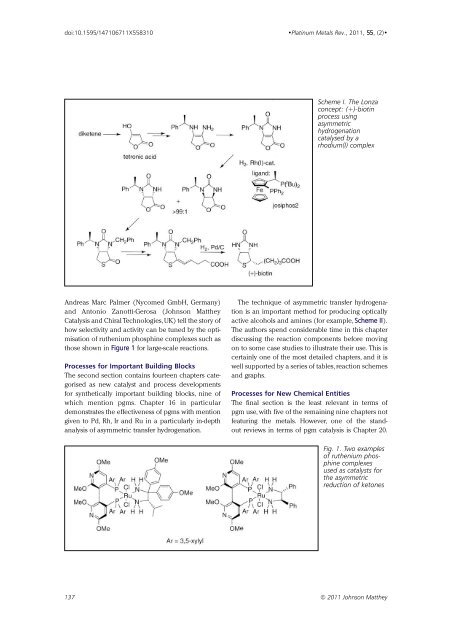Download - Platinum Metals Review
Download - Platinum Metals Review
Download - Platinum Metals Review
You also want an ePaper? Increase the reach of your titles
YUMPU automatically turns print PDFs into web optimized ePapers that Google loves.
doi:10.1595/147106711X558310<br />
•<strong>Platinum</strong> <strong>Metals</strong> Rev., 2011, 55, (2)•<br />
Scheme I. The Lonza<br />
concept: (+)-biotin<br />
process using<br />
asymmetric<br />
hydrogenation<br />
catalysed by a<br />
rhodium(I) complex<br />
Andreas Marc Palmer (Nycomed GmbH, Germany)<br />
and Antonio Zanotti-Gerosa (Johnson Matthey<br />
Catalysis and Chiral Technologies, UK) tell the story of<br />
how selectivity and activity can be tuned by the optimisation<br />
of ruthenium phosphine complexes such as<br />
those shown in Figure 1 for large-scale reactions.<br />
Processes for Important Building Blocks<br />
The second section contains fourteen chapters categorised<br />
as new catalyst and process developments<br />
for synthetically important building blocks, nine of<br />
which mention pgms. Chapter 16 in particular<br />
demonstrates the effectiveness of pgms with mention<br />
given to Pd, Rh, Ir and Ru in a particularly in-depth<br />
analysis of asymmetric transfer hydrogenation.<br />
The technique of asymmetric transfer hydrogenation<br />
is an important method for producing optically<br />
active alcohols and amines (for example, Scheme II).<br />
The authors spend considerable time in this chapter<br />
discussing the reaction components before moving<br />
on to some case studies to illustrate their use. This is<br />
certainly one of the most detailed chapters, and it is<br />
well supported by a series of tables, reaction schemes<br />
and graphs.<br />
Processes for New Chemical Entities<br />
The final section is the least relevant in terms of<br />
pgm use, with five of the remaining nine chapters not<br />
featuring the metals. However, one of the standout<br />
reviews in terms of pgm catalysis is Chapter 20.<br />
Fig. 1. Two examples<br />
of ruthenium phosphine<br />
complexes<br />
used as catalysts for<br />
the asymmetric<br />
reduction of ketones<br />
137 © 2011 Johnson Matthey
















